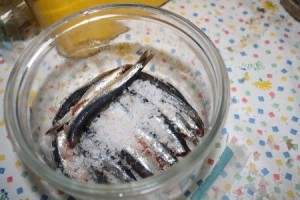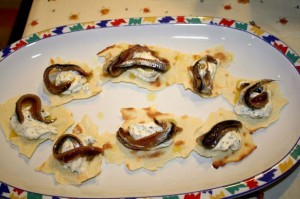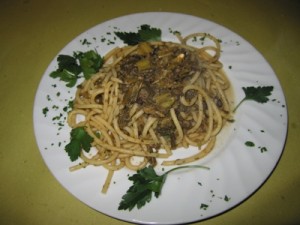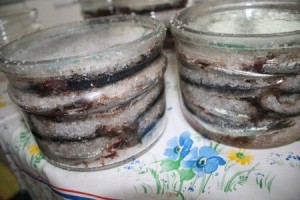Acciughe sotto sale fatte in casaHomemade salted anchovies
Una ricetta tipica ligure che si tramanda nel tempo. E’ una delle tecniche di conservazione degli alimenti più antica e quella che offre forse le più alte soddisfazioni.
Le acciughe sotto sale sono una prelibatezza che potrete usare nei vostri antipasti, oppure dare maggior gusto ai vostri piatti.
Basta prepararle una volta all’anno per averle sempre a disposizione.
Procedimento
Per prima cosa dovete pulire bene le acciughe.
Procedete con il levare loro la testa e le interiora in questo modo: spezzate il pesce con le mani, staccando la testa e tirando. In questo modo vedrete che verranno via anche le interiora.
Ricordate i pesci non vanno nè lavati nè bagnati per nessun motivo.
Ponetele per un paio d’ore in un colapasta mischiate a 2-3 cucchiai di sale in modo da far perdere il sangue.
Spargete uno strato di sale grosso di circa 1 cm. all’interno del vaso, che utilizzerete per conservarle, che dovrà essere ben pulito e asciutto.
Sopra lo strato di sale grosso create uno strato compatto di acciughe attaccate l’una all’altra, in questo modo: riponete una acciuga alla volta rispettando l’ordine una con la testa da una parte e la seconda con la testa dove quella prima ha la coda, per ottimizzare gli spazi e non lasciare nessun buco tra di esse.
Fatto lo strato di pesci, ricopriteli con uno strato abbondante di sale grosso, sempre evitando di lasciare buchi da riempire con il sale.
Ripetete gli strati, uno di acciughe e uno di sale allo stesso modo fatto precedentemente fino ad arrivare quasi in cima al vaso, lasciando circa 2 – 3 cm dalla fine del bordo.
L’ultimo strato deve essere di sale grosso che ricopra tutto senza lasciare buchi. Appoggiate a questo punto sopra l’ultimo strato di sale una retina, un tappo forato o comunque una pellicola che ricopra il contenuto ma che lo lasci areare.
Sopra questo tappo dovrete metterci un peso, anticamente, ed è la soluzione più usata ancora oggi, si utilizzava un sasso pesante preso dal mare, altrimenti tranquillamente potrete metterci una bottiglia da un litro e mezzo piena d’acqua.
Il vaso con le acciughe salate dovrà essere conservato sopra un piatto, in un luogo fresco, buio e asciutto per 2 mesi.
Durante questo periodo dovrete andare a controllare ogni tanto le acciughe prestando attenzione a un paio di accorgimenti:
– i pesci schiacciati perderanno liquidi che traboccheranno dal vaso e coleranno nel piatto sotto il vaso. Dovrete quindi pulire il piatto e rimetterlo sotto il vaso.
– la salamoia prodotta potrebbe creare delle bolle d’aria. In questo caso basterà scrollare un pò il vaso per far salire le bolle e poi rimettere il tutto come prima
.
Le acciughe sotto sale, passati i due mesi, saranno pronte e potrete conservarle fino a 2 – 3 anni. Qualora la salamoia evaporasse non lasciate mai i pesci all’asciutto e aggiungete una salamoia fatta da voi (acqua e sale in soluzione satura).
Passati i due mesi potrete gustare le acciughe sotto sale a vostro piacere.
Con una forchetta togliete una per una le acciughe (quelle che vi occorrono), apritele a metà, togliete la lisca centrale e sciacquatele sotto l’acqua del rubinetto per togliere il sale della conserva.
 In fase di desalatura e pulizia del pesce attenzione a che l’acqua dolce (nemmeno una goccia) non vada nel vaso dove rimarranno conservate le altre altrimenti le acciughe potrebbero ammuffire.A typical Ligurian recipe handed down over time. And one of the techniques of food preservation oldest and perhaps the one that offers the highest satisfaction.
In fase di desalatura e pulizia del pesce attenzione a che l’acqua dolce (nemmeno una goccia) non vada nel vaso dove rimarranno conservate le altre altrimenti le acciughe potrebbero ammuffire.A typical Ligurian recipe handed down over time. And one of the techniques of food preservation oldest and perhaps the one that offers the highest satisfaction.
Salted anchovies are a delicacy that you can use in your appetizers, or give more flavor to your dishes.
Just prepare once a year to have it available.
Method
First you must thoroughly clean the anchovies. Proceed to raise their heads and entrails in this way: broke the fish with hands detaching the head and pulling. This way you will see that will come away the entrails. Remember the fish should not be neither washed nor wet for any reason. Place them for a couple of hours in a colander mixed with 2-3 tablespoons of salt so as to remove the blood. Spread a layer of salt of about 1 cm. inside the jar, you’ll use to keep them, which must be clean and dry. Over the layer of salt created a compact layer of anchovies attached to one another, in this way: Place one anchovy at a time in the order with a head on one side and the second with the head where the first one has tail, to optimize space and not leave any holes between them.

Done the layer of fish, cover them with a generous layer of salt, always avoiding to leave holes to fill with salt.
Repeat the layers, one anchovy and one of salt in the same manner previously done almost down to the top of the jar, leaving about 2 – 3 cm from the end of the edge. The last layer must be salt that covers all without leaving holes. Place at this point above the last layer of salt a retina, a perforated cap or in any case a film that covers the content but which leave it to ventilate. Above this you need to put a weight, in ancient times and is the most widely used today, it used a heavy stone taken from the sea, otherwise you can safely put a bottle and a half liters of water. The jar with the salted anchovies must be kept on a plate, in a cool, dark, dry place for two months.
During this time you’ll have to go check every now and anchovies paying attention to a few tricks:
– Squashed fishes lose liquid that will overflow from the jar and leak into the dish under the pot. You will need to clean your plate and put it back in the pot.
– The brine produced could create air bubbles. In this case, you just shake the pot a bit to pick up the bubbles and then put the business as usual.
Salted anchovies, passed two months, will be ready and you can store up to two to three years. If the brine evaporates never leave the fish dry and add a brine made by you (water and salt in a saturated solution). Past two months served salted anchovies at your leisure.
With a fork, remove one by one the anchovies (what you need), open them in half, remove the central bone and rinse under tap water to remove the salt of the preserve.
 When desalting and cleaning the fish care that fresh water (not a drop) does not go in the jar where they will remain preserved other otherwise anchovies may become moldy.
When desalting and cleaning the fish care that fresh water (not a drop) does not go in the jar where they will remain preserved other otherwise anchovies may become moldy.





Leave a comment